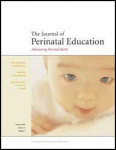 ICAN President Desirre Andrews and Advocacy Director Gretchen Humphries have recently published an article in the Journal of Perinatal Education. Desirre and Gretchen call for childbirth professionals to work together with advocates to promote change so that childbearing women can be empowered to seek the best care for themselves and their babies.
ICAN President Desirre Andrews and Advocacy Director Gretchen Humphries have recently published an article in the Journal of Perinatal Education. Desirre and Gretchen call for childbirth professionals to work together with advocates to promote change so that childbearing women can be empowered to seek the best care for themselves and their babies.
Tackling the topics of cesarean surgery and vaginal birth after cesarean (VBAC) is an increasing challenge for the birth professional even though scientific evidence clearly supports reducing the skyrocketing cesarean rate and increasing the support for and availability of VBACs for childbearing women. We need to ask why this is so…
Using RCS and VBAC as an example of the broader issues within the current maternity care system, we can identify some of the issues facing both the birth professional and the consumer. Looking at the published evidence about cesarean and VBAC is both heartening and disheartening: heartening because the evidence is that, although cesareans are safer than ever before, they should be used in a judicious manner (not prophylactically), and VBAC is a safe, viable option for most women who have had a previous cesarean; disheartening because, even with tens of thousands of research dollars having been spent in the past two decades to define the risks and benefits of VBAC and RCS, the evidence has not translated into education and medical practice. We maintain that the failure to accurately communicate the risks and benefits of RCS versus VBAC is a stumbling block that needs to be addressed in order to apply the gathered evidence to good practice.
Desirre and Gretchen suggest several ways that childbirth professionals can help overcome this stumbling block.
- Childbirth educators:
Many couples attend a childbirth preparation course. Within the curriculum, there is usually some discussion of cesarean surgery. Research has shown that if a woman is told about the option of VBAC at the time of her cesarean, she is more likely to have a VBAC. A discussion of the realities of post-cesarean pregnancy and the validity of VBAC as a choice would also serve this purpose… Childbirth educators have the opportunity and ethical requirement to give the most accurate and up-to-date information about birth practices, even when it does not reflect current practice on the labor and delivery floor.
- Doulas:
Although a doula cannot speak for her client, she can be a force for best practice if she has adequately prepared her client for the realities of the labor and delivery floor and is not afraid to speak the truth when the client is buffeted by conflicting information. ‘‘Preserving the experience’’ is a false positive outcome when ultimately the experience has negative repercussions in the months and years to follow, no matter what the client may describe in the hours and days after giving birth. ICAN knows that women appreciate honesty, even honesty that is difficult to hear. This is truth that doulas are well equipped to speak.
- Labor and delivery nurses:
A supportive nurse can make the difference when a woman seeks a low-intervention labor or wavers in the face of the difficulties of labor. And there is no doubt that the nurse is also often caught in the middle of the conflict between the patient and the machinery of institutionalized maternity care…Nevertheless, nurses are called to advocate for their patients, and this is no less true on the labor and delivery floor than in the cardiac wing…A commitment to staying current with the evidence for best practice through continuing education and working as a profession to support best practice is required to effect any real change within the hospital system. To do anything less is to compromise the very principles of nursing.
To summarize, Desirre and Gretchen point to ICAN as an example for all childbirth professionals:
More often than not, ICAN is the only source of evidence-based information on the risks and benefits of RCS and VBAC and the only source of support for a decision to choose VBAC. If we have any hope of derailing the juggernaut of worsening maternal and fetal outcomes in the United States, the wider worldwide childbirth community must begin to support and educate as ICAN does.